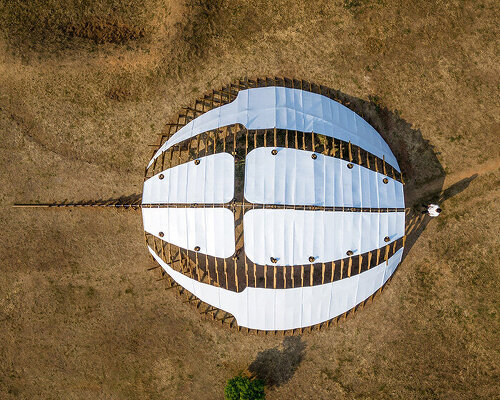Cheng Tsung FENG builds outdoor installation in Taiwan
Cheng Tsung Feng unveils Dragon Palace III in Kinmen, Taiwan, an outdoor installation that draws from the ancient horseshoe crab as both architectural form and cultural symbol. Set on Kinmen Island, where the species has long shaped local ecological and mythological narratives, the work translates the distinctive anatomy of the creature into a timber-and-canvas structure that operates as part shelter and part sculptural landmark. The project draws on Feng’s deep engagement with traditional craft, using wood, rope, and fabric to evoke the creature’s protective shell while creating a space for communal gathering and reflection.
The core structure of the installation emerges from an arching wooden framework that echoes the curvature of the horseshoe crab’s carapace. White canvas is draped in layered sections over the timber skeleton, forming an enclosure. Intentional gaps allow beams to pierce through the surface, creating moments where sharp edges interrupt the smoothness of the canvas. This interplay recalls the duality embedded in the creature itself, whose body is shaped for defense yet delicate in its ecological role, a so-called ‘living fossil’ that has endured for more than 400 million years.
all images by Fixer Photography Studio
Dragon Palace III draws from the Horseshoe Crab shell
Through Dragon Palace III Kinmen, Cheng Tsung Feng turns the primordial figure of the horseshoe crab into a space that carries ecological memory and communal resonance. The Taiwanese artist’s installation becomes a ceremonial chamber, defined by filtered daylight, timber ribs overhead, and the tactile simplicity of natural materials. The construction techniques that include tying, bending, and binding reference island traditions while keeping the structure resolutely contemporary. Visitors step into a sanctuary that frames Kinmen’s connection to land and sea.
As evening arrives, soft light spreads across the canvas shell and along its elongated, tail-like extension, introducing a dreamlike quality that shifts the reading of the form. The structure appears to stir, as if a mythic creature has surfaced from the shoreline. This nocturnal presence hints at the island’s folklore, echoing the idea of hidden palaces rising from the sea and blurring distinctions between natural history and imagination.
Cheng Tsung Feng unveils Dragon Palace III in Kinmen, Taiwan
the outdoor installation draws from the ancient horseshoe crab
set on Kinmen Island, where the species has long shaped local ecological and mythological narratives
the work translates the distinctive anatomy of the creature into a timber-and-canvas structure
part shelter and part sculptural landmark
rhe project draws on Feng’s deep engagement with traditional craft
using wood, rope, and fabric to evoke the creature’s protective shell
a space for communal gathering and reflection
the core structure of the installation emerges from an arcing wooden framework
echoing the curvature of the horseshoe crab’s carapace
white canvas is draped in layered sections over the timber skeleton
intentional gaps allow beams to pierce through the surface
as evening arrives, soft light spreads across the canvas shell and along its elongated, tail-like extension
project info:
name: Dragon Palace III Kinmen
artist: Cheng Tsung Feng
location: Jinning, Kinmen, Taiwan
photographer: Fixer Photography Studio | @fixer_photographic_studio
designboom has received this project from our DIY submissions feature, where we welcome our readers to submit their own work for publication. see more project submissions from our readers here.
edited by: thomai tsimpou | designboom
The post arching timber shell installation by cheng tsung feng evokes the horseshoe crab in taiwan appeared first on designboom | architecture & design magazine.

